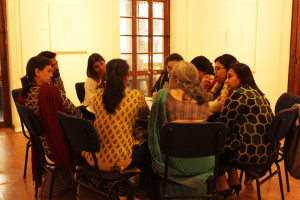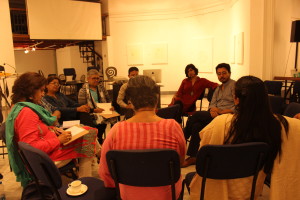The International Conference on Teaching History 2016-‘The Idea of Nationalism’ sought to explore what is arguably the most contested word in recent times—nationalism and bring it into the classroom context. Participants from all over the subcontinent gathered for three days at The Harrington Street Arts Centre, Calcutta to discuss and debate, listen and share.
This year’s conference saw an addition to the proceedings that gave participants time to process and discuss points that had been raised during talks and panel discussions—a dedicated time for reflection on all three days. Participants were divided into five groups, which also included speakers.
On the first two days participants discussed the days proceedings as well as general points on education, schooling, curriculum, multi-perspectives and of course, the topic at hand—Nationalism.
One group felt that the influence of educators over students has decreased as a result of students being exposed to a variety of inputs, for instance, the Internet and that child’s upbringing plays a huge role in moulding his or her ideology. The lines between nationalism and patriotism are blurred, with emotion being co-opted in nationalism thereby disguising it as patriotism. Participants felt that very often, Muslims are always questioned with regards to their patriotism, and that patriotism is not something that needs to be proved.
Another group discussed extensively what makes a bad educator—the tendency to control, or try to control the thought processes of students and the need to instill fear into their students. A good teacher on the other hand, has a passion for teaching, is not condescending and is loving. It is not about what you teach, but how you teach that makes the difference.
On the final day, the participants were asked to discuss points that had been brought up during the conference, and how they would take it back to their classroom. One of the groups decided that the use of the video ‘Hopscotch’ shared by Malik Sajad, one of the speakers on Day 3, could be very easily used in classrooms. Sameer, an educator from Pakistan suggested that the video could be screened in classrooms on both sides of the border and the students be asked to do similar activities, for instance, writing an essay. The outcome could be shared, automatically leading to multi-perspectives. They also suggested virtual exchange programs. Another group suggested the use of videos and interviews to reconceptualise the idea of nationalism.
A point raised by another group was one mentioned by Jerry Pinto—that history is happening all the time and also that multi-perspectives are important, as shown in the presentation by Yousuf Saeed. They used these points as the basis of their takeaway. Using the example of demonetization they discussed a classroom assignment idea which involved students developing a questionnaires—questions like how does it affect you and why was it done. This questionnaire is taken to a wide cross section of people, thereby bringing in the idea of multi-perspectives—one event, but more than one reaction to it.
–Paroma Sengupta


